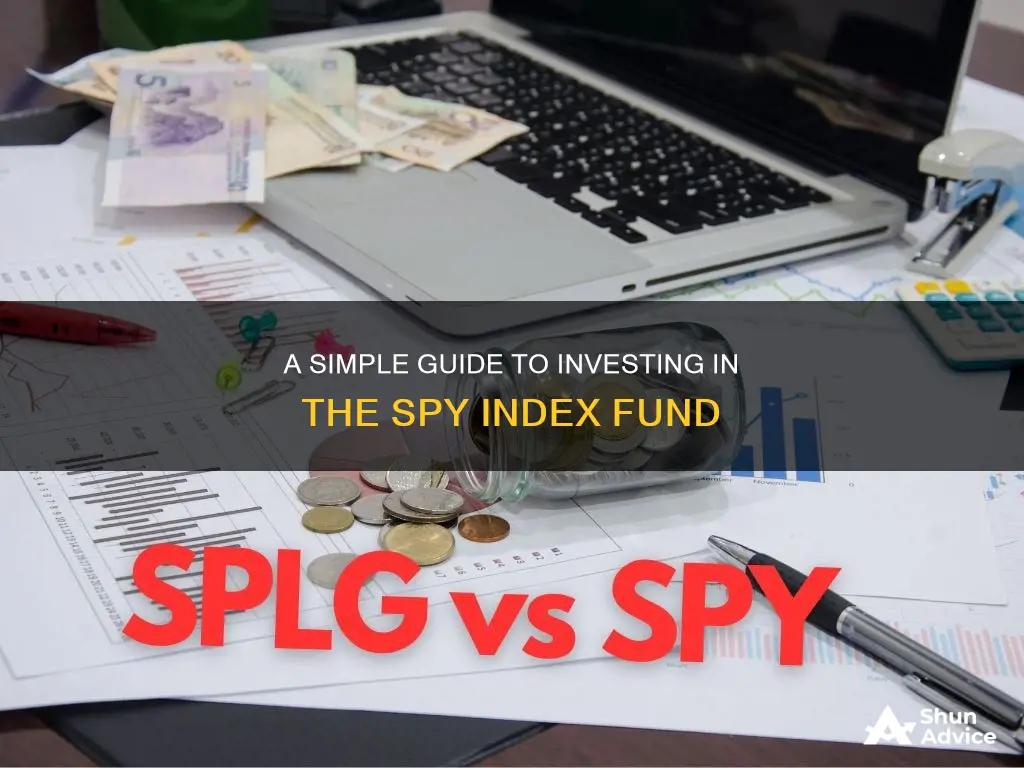
The SPDR S&P 500 ETF Trust (SPY) is the largest exchange-traded fund (ETF) in existence, with about $500 billion in assets under management as of May 2024. Launched by State Street Global Advisors in 1993, it was also the first U.S.-listed ETF and is the most-traded ETF in the world. The SPY ETF is a good investment option for those looking to diversify their portfolios and gain exposure to the world's leading companies without the effort of purchasing individual stocks. In this article, we will discuss how to invest in the SPY ETF, including the steps to buying shares, the benefits and drawbacks of investing in this fund, and how to decide if it is the right investment for you.
| Characteristics | Values |
|---|---|
| Fund Name | SPDR S&P 500 ETF Trust |
| Other Names | SPY ETF |
| Launch Date | January 1993 |
| Type | Exchange-Traded Fund (ETF) |
| Investment Objective | Seeks to provide investment results that, before expenses, correspond generally to the price and yield performance of the S&P 500® Index |
| Holdings | Tracks the performance of the S&P 500 index, i.e., 500 leading U.S. companies |
| Top Holdings | Microsoft, Apple, Nvidia, Amazon, Meta Platforms, Alphabet, Berkshire Hathaway, Eli Lilly, Broadcom |
| Sectors | Information Technology, Consumer Discretionary, Communication Services |
| Expense Ratio | 0.0945% |
| Brokerage Account | Required to buy shares; can be bought and sold like stocks |
| Investment Amount | No minimum investment mentioned; fractional shares available |
| Dividend Yield | 1.39% (as of March 31, 2024) |
What You'll Learn

Opening a brokerage account
To invest in the SPDR S&P 500 ETF Trust, you'll need to open a brokerage account. You can do this online, as long as you're 18 or over. You'll need to provide some identifying information, such as your address, Social Security number, date of birth, and possibly your employer's name.
You'll also need to choose the type of account you want. You could open a taxable brokerage account if you're investing money that you may need before you retire. But if you're investing for the long term, consider buying the SPDR S&P 500 ETF Trust in an individual retirement account (IRA). This could be a smart move because you can lock in a tax break.
- Compare different brokerage firms and the services they offer. Look for one that meets your needs and aligns with your budget. Some brokerage firms offer low-fee trading options.
- Be prepared to provide personal information, such as your Social Security number and date of birth, when opening an account.
- Decide how much money you want to deposit into the account. This will depend on your budget and investment goals.
- Consider the types of investments you want to make. If you're primarily interested in the SPY ETF, look for a brokerage account that offers access to exchange-traded funds (ETFs).
- Research the fees and expenses associated with the brokerage account. For example, some accounts may charge commissions or maintenance fees.
- Review the account agreement and disclosure statements carefully before opening an account.
- If you have any questions, don't hesitate to contact the brokerage firm's customer support for more information.
Funding Investments: Strategies for Covering Total Amounts Received
You may want to see also

Figuring out your budget
You may not want to put all your money into the ETF at once, though. Many investors use a strategy called dollar-cost averaging, where they invest on a set schedule. This helps you lock in some low prices because you'll automatically purchase some shares when the market is down.
It's important to do your homework with any investment, and the SPDR S&P 500 ETF is no different. Familiarize yourself with the investment prospectus, and learn not only how the fund works but also the alternatives. One good thing about investing in a top S&P 500 index fund is that you don't need to scrutinize balance sheets and other financial statements like you would if you were buying individual stocks. A company needs a history of profitability just to be included in the S&P 500 index. Plus, if some stocks perform poorly, you're somewhat insulated because you're investing across 500 different companies.
If you're investing for retirement, consider an S&P 500 ETF like the SPDR S&P 500 ETF Trust in an individual retirement account (IRA). This can be a smart move because you can lock in a tax break.
A Beginner's Guide to Investing in NZ Index Funds
You may want to see also

Choosing an investment account
There are a few different types of investment accounts you can use to invest in the SPY index fund. Each has its own advantages and considerations, so it's important to understand the differences before deciding which one is right for you.
One option is a taxable brokerage account. This is a good choice if you're investing money that you may need before retirement. With a taxable brokerage account, you can easily buy and sell investments, and you won't be restricted by the same contribution limits as some other types of accounts. However, keep in mind that you'll need to pay taxes on any gains you make each year.
Another option is an individual retirement account (IRA). This type of account offers tax advantages, making it a smart choice if you're investing for the long term. With an IRA, you may be able to deduct your contributions from your taxable income, and your investments can grow tax-free until you withdraw them in retirement. However, there are usually limits on how much you can contribute each year, and you may face penalties if you withdraw your money before a certain age.
Additionally, you could consider investing through your employer-sponsored retirement plan, such as a 401(k). This can be a convenient option if your plan includes S&P 500 index funds or ETFs as investment choices. Similar to an IRA, a 401(k) offers tax advantages, and your investments can grow tax-free until withdrawal. However, the investment options available in a 401(k) are typically more limited compared to a brokerage account or IRA.
Finally, you could use a robo-advisor platform to invest in the SPY index fund. Robo-advisors use algorithms to build and manage investment portfolios for their clients. This can be a good option if you want a more hands-off approach to investing, as the platform will automatically manage your portfolio based on your goals and risk tolerance. However, robo-advisors typically charge an annual fee for their services, so be sure to consider the cost before deciding.
When choosing an investment account, it's important to consider your financial goals, time horizon, and tax situation. If you're investing for the long term and want to take advantage of tax benefits, an IRA or 401(k) could be a good choice. On the other hand, if you want more flexibility and control over your investments, a taxable brokerage account may be more suitable.
CEF Funds: Where the Rich Invest Their Money
You may want to see also

Understanding the pros and cons
The SPDR S&P 500 ETF Trust (SPY) is a popular investment choice as it offers the potential for stable long-term returns, a diversified portfolio, and low fees. However, it's important to consider the downsides before investing. Here are some pros and cons of investing in the SPY:
Pros:
- Diversification: The SPY provides automatic diversification by investing in 500 large-cap U.S. companies across multiple sectors, reducing the risk of being significantly impacted by the performance of a single stock.
- Passive investment strategy: The SPY is passively managed, meaning it tracks the S&P 500 index without requiring active fund management. This results in lower management fees compared to actively managed funds.
- Long-term performance: The S&P 500 index has consistently performed well over the long term, making the SPY a good choice for investors seeking stable, long-term returns.
- Efficiency: The SPY offers an efficient way to gain exposure to the U.S. equity market without having to invest in multiple stocks individually.
- Tax advantages: ETFs generally have tax advantages over mutual funds as they result in fewer taxable events, leading to lower capital gains taxes.
Cons:
- Large-cap dominance: The S&P 500 index is dominated by large-cap companies, limiting exposure to small-cap and mid-cap stocks with potentially higher growth rates.
- Equity risk: The SPY carries the inherent risks of investing in equities, such as market volatility and downside risk, which may be challenging for newer investors.
- U.S.-focused: The SPY only includes U.S. companies, providing exposure solely to the U.S. market and missing out on international investment opportunities.
- Management fees: While the SPY has a low expense ratio compared to actively managed funds, it has higher fees than some other ETFs tracking the S&P 500, such as the Vanguard S&P 500 ETF (VOO).
- Short-term limitations: Index funds like the SPY are designed for long-term investments and may not provide the flexibility to respond quickly to market changes, resulting in fewer opportunities for short-term growth.
Invest in HDFC Mutual Fund: Secure Your Future
You may want to see also

Knowing the best time to invest
Diversification and Market Conditions:
SPY, or the SPDR S&P 500 Trust, is an exchange-traded fund (ETF) that tracks the performance of the S&P 500 index, providing exposure to a diverse range of sectors and companies. When considering the timing of your investment, assess the overall market conditions and diversification opportunities within the SPY ETF. Look at the sector weightings and evaluate if they align with your investment strategy. The largest sectors in the S&P 500 are typically information technology, health care, and financials, which can influence the performance of the fund.
Expense Ratio and Fees:
Before investing, it's essential to understand the costs associated with the SPY ETF. Consider the expense ratio, which represents the annual management fee as a percentage of your investment. While SPY has a relatively low expense ratio compared to other funds, it's crucial to factor in these costs as they can impact your returns over time.
Time Horizon and Investment Goals:
Determine your investment time horizon, which is the length of time you plan to hold the investment. SPY is often considered a long-term investment due to its potential for short-term volatility. Assess your financial goals and decide if SPY aligns with your objectives. If you're investing for retirement, for example, SPY can be suitable as it offers a diversified mix of established companies.
Dollar-Cost Averaging:
Consider using a strategy called dollar-cost averaging, where you invest a fixed amount at regular intervals. This approach helps smooth out the impact of market fluctuations and ensures you purchase shares at different price points, potentially lowering your average cost per share.
Market Trends and Historical Performance:
While past performance doesn't guarantee future results, studying historical market trends can provide insights. Analyze long-term performance data for the S&P 500 and SPY ETF to identify patterns and potential opportunities. Keep in mind that the stock market can be volatile in the short term, so a longer time horizon can help mitigate some of the risks.
Risk Tolerance and Emergency Funds:
Evaluate your risk tolerance before investing. Ensure you have adequate emergency savings and have addressed high-interest debt or other financial priorities. Investing in SPY carries inherent risks, and you should be comfortable with the potential for short-term losses in exchange for long-term gains.
By considering these factors and conducting thorough research, you can make a more informed decision about the best time to invest in the SPY index fund. Remember that investing involves risks, and it's always recommended to consult with a qualified financial advisor to determine if an investment aligns with your specific circumstances and goals.
Mutual Funds: A Smart, Secure Investment Choice
You may want to see also
Frequently asked questions
The SPY index fund, also known as the SPDR S&P 500 ETF Trust, is an exchange-traded fund (ETF) that tracks the performance of the S&P 500 index. It is the largest and most-traded ETF in the world.
To invest in the SPY index fund, you need to open a brokerage account and purchase shares of the fund. You can buy shares of the fund just like you would buy stocks, and you can choose to invest a set dollar amount or purchase a specific number of shares.
Investing in the SPY index fund offers instant diversification, as it provides exposure to 500 large U.S. companies across various sectors. It also has a strong track record of delivering consistent long-term returns.
As with any investment, there are risks associated with investing in the SPY index fund. The fund is subject to market volatility and is dominated by large-cap companies, which means it has limited exposure to small- and mid-cap stocks. Additionally, it only includes U.S. companies, so it lacks international diversification.







